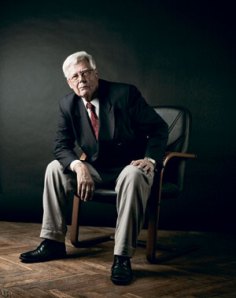On October 21, the labor union of the Engineering Center of the Experimental-Design Bureau (OKB) named for A. I. Mikoyan went public with its claim that well-known aircraft maker RSK MiG is in a catastrophic state. Metronews.ru published part of the union’s open appeal as well as MiG’s official reaction. The union’s letter is addressed to the president, prime minister, and heads of political parties, and dated October 11.
Union chairman Yuriy Malakhov says:
“The situation taking shape in our engineering center forced me to write this letter. We’ve always been the brain of the company, it’s right here that new aircraft models were developed. For a long time, we’ve had no new orders. In the past five years, six general directors have been replaced, they all come from the Sukhoy company, and the impression’s created that they are strangling us, they want to close our company. All the best orders go there [Sukhoy]. For example, we aren’t even allowed to participate in developing unmanned aerial vehicles. Sukhoy is working on them, but this aircraft company doesn’t have our experience. They focused on heavy fighters. The pay of our colleagues is lower than in the trolleybus yard next door. Lead engineers get 8-10 thousand rubles [per month]. Sometimes with occasional bonuses they get 30 thousand. Talented young specialists leave for other firms, for example, Boeing, where they get two-three times more. Now 10 percent of orders come from Russia, the rest from abroad. In the course of several years we tried to get a response from our leadership, but no one wanted to start negotiations with us. And the engineering center’s director decided to meet with employees only after this letter. We are very much hoping for this meeting. We expect new orders and increased wages.”
MiG’s press-secretary offered this response:
“The absence of the Gosoboronzakaz in the 1990s was a serious blow to the country’s defense industry, including to RSK MiG. Only those companies that had large export contracts could develop successfully, for example in that period the Sukhoy company managed to conclude contracts with India and China. At that moment, MiG had only a contract with Malaysia. In recent years, RSK MiG’s been headed by directors from Sukhoy corporation – Nikitin, Fedorov, Pogosyan, Korotkov. From outside this could look like a raider’s seizure of MiG. But who needs to seize debts and problems? A positive dynamic began precisely with the arrival of these people – large foreign contracts were signed, the contract with the Defense Ministry to supply MiG-SMT. Aircraft were supplied against this contract and they’re being successfully employed in the RF VVS. Presently, a contract with the Defense Ministry to supply the MiG-29K is being discussed.”
“Today RSK MiG’s order portfolio is more than $4 billion, serial production of new aircraft is unfolding. There is a positive dynamic, maybe it’s not as quick and wages not as high as all of us would like. Some young specialists come and stay, some leave. But on the whole the company has good prospects.”
A couple points on these claims. We know raiders take and sell what’s good, and leave “debts and problems” behind. The Defense Ministry’s acceptance of the Algerian MiG-SMTs was more a financial bailout for the company and face-saving maneuver for Russia writ large than a real contract. Not mentioned is Aleksandr Sukhorukov’s October 11 statement that MiG-29K procurement won’t come until 2013-2015.
The text of the union’s letter says MiG is simply dying. It cites many problems and complaints, including a 48-billion-ruble debt, losses and delays in contracts, moving engineers to Zhukovskiy, closing MAPO, etc. It says crucial pay bonuses can’t always be paid, and MiG is just supplying skilled people to Sukhoy and Irkut. The letter calls OAK an incomprehensible middle layer blocking competition, but allowing personal lobbying. Finally, it blames Mikhail Pogosyan for closing MiG’s promising future projects.
Scanning other recent MiG headlines – the Indian tender wasn’t the only blow to the MiG-35, its chances with the Russian Air Forces didn’t look too rosy anyway, and the early September MiG-31 crash indicated again what dire straits that old airframe is in.
Izvestiya’s Ilya Kramnik published recently on the MiG-29’s fate. He wrote that (unlike the Su-27 or Su-24) the Defense Ministry doesn’t plan to modernize the MiG-29. His military source says replacement of these worn-out aircraft in the future is deemed more cost-effective.
Kramnik’s source describes production of the generation “4+++” (?!) MiG-35 as an unavoidable but not yet decided step. He sees the MiG-29 variant line ending since it’s outclassed by updated Su-27s.
Kramnik’s OPK source sees 20 or 24 MiG-35s being produced each year, for about 25 billion, to replace 150 or 160 MiG-29s in Russia’s inventory.
He cites Konstantin Makiyenko who sees the MiG-35 as important not just as a MiG-29 replacement, but also to keep Russia in the light- to medium-, $60-million-range fighter export market and not leave this industry segment to China and its J-10.
But Konstantin Bogdanov tells Kramnik he thinks the MiG-35’s loss in the Indian tender hurt its chances at home because it raises questions about MiG’s ability to support a production program for the Russian Air Forces.
One also wonders how much MiG-35 and MiG-29 will be needed with T-50 / PAK FA, with Su-35, and with Su-27 upgrades out there.
It’s hard to see the MiG story as anything but another chapter in the painful and necessary process of post-Cold War industrial downsizing and restructuring. After all, the U.S. is down basically to Boeing and Lockheed Martin. In MiG’s case, one can question whether the selection is really natural and the fittest are truly surviving. The answer is probably yes. However they managed it, Sukhoy and Irkut played their post-Soviet hand better, and it shows today. The Russian aviation sector will be better off with further consolidation. Still it doesn’t need Sukhoy to be a monopolist. Managing that outcome will be tricky.


